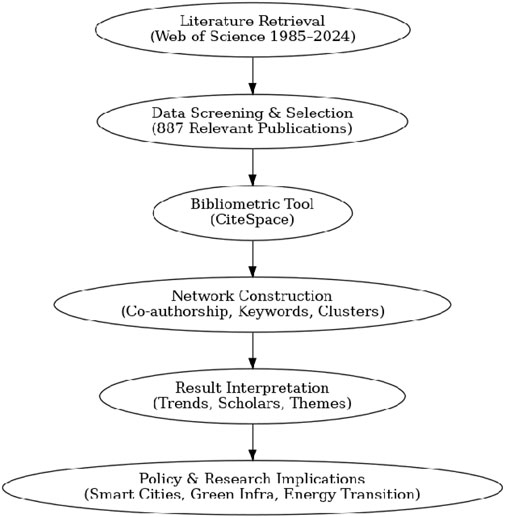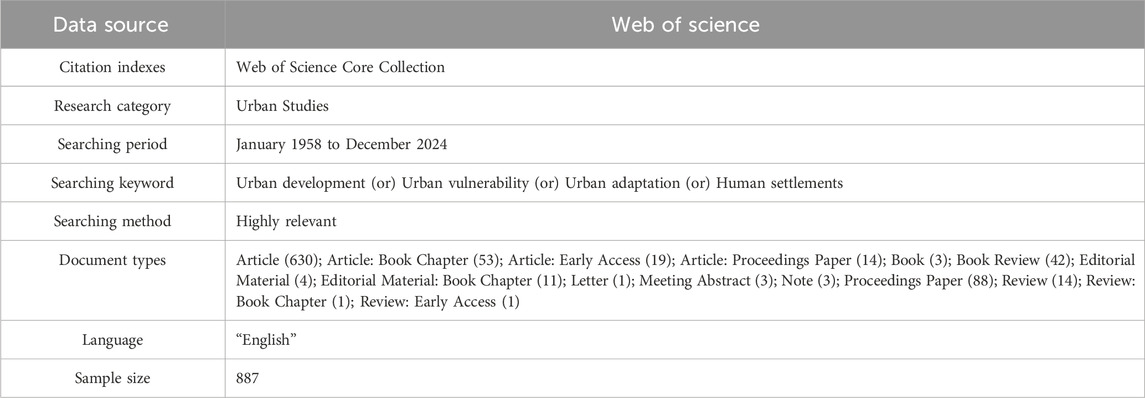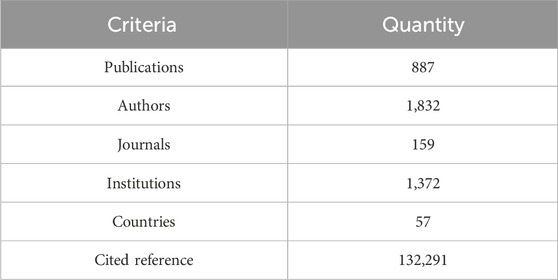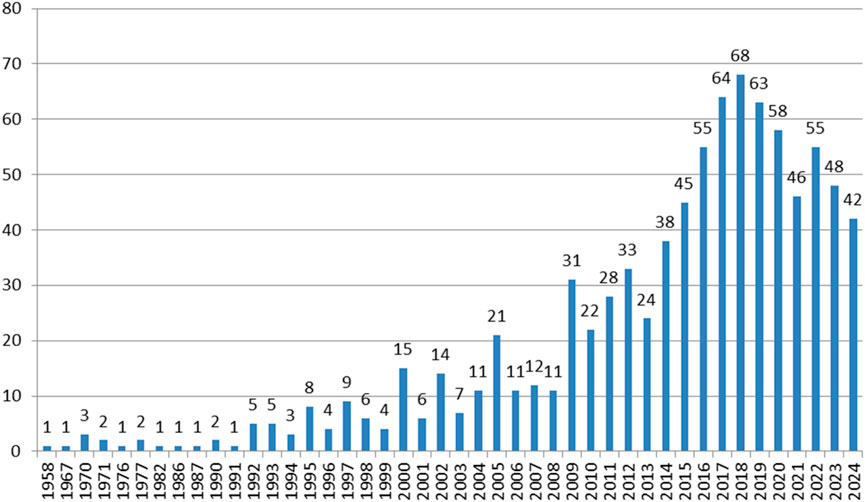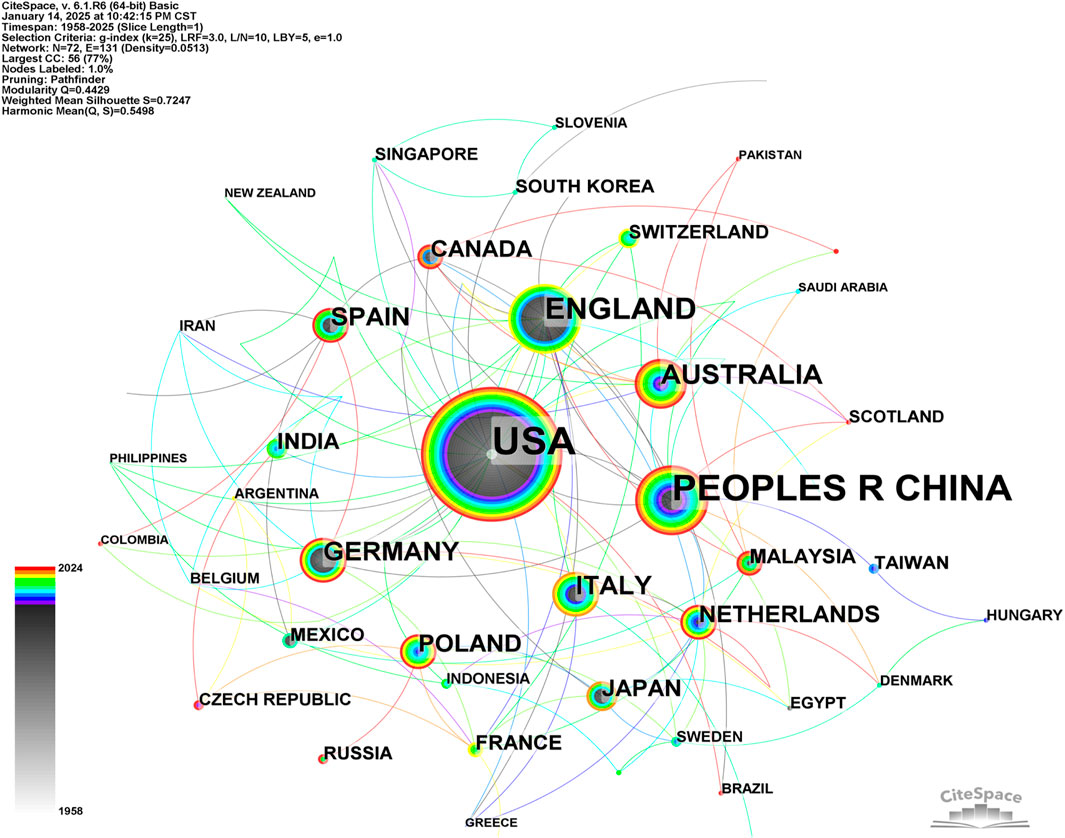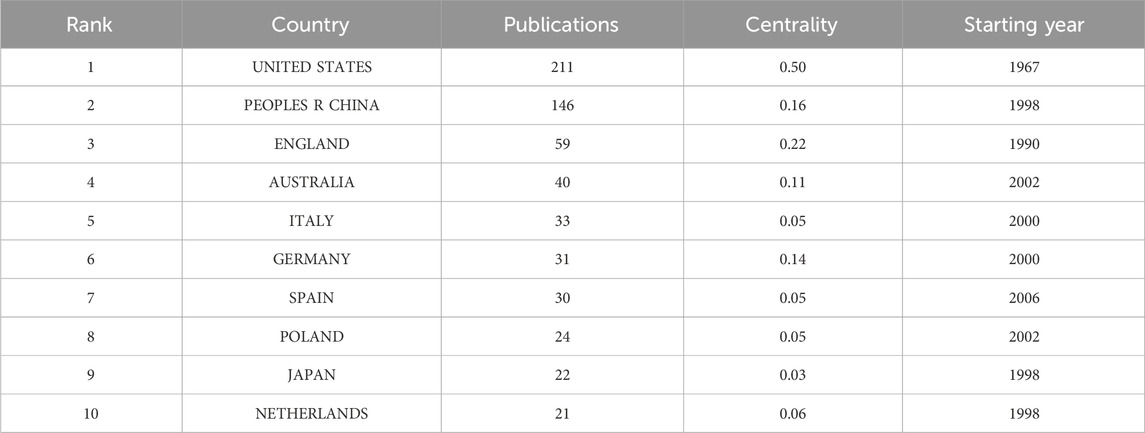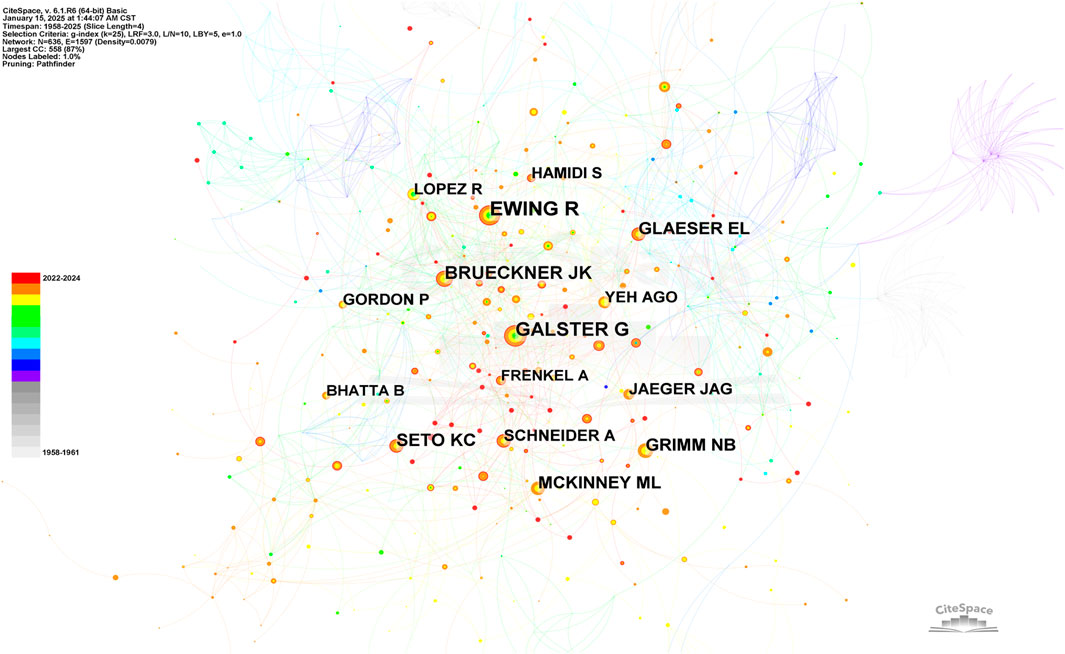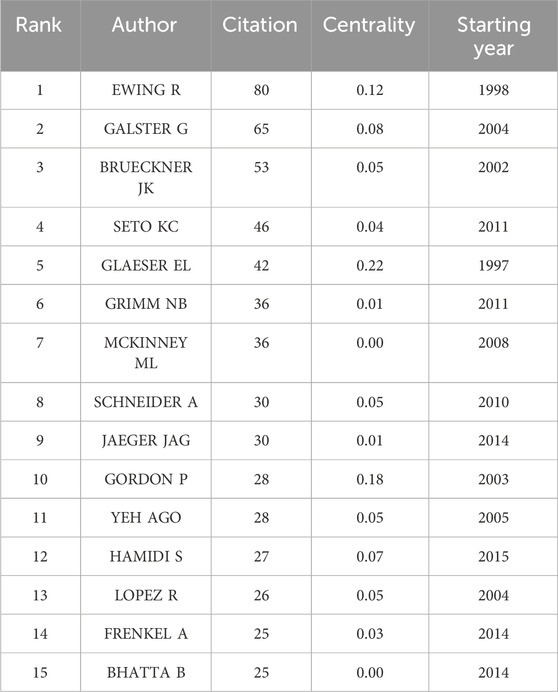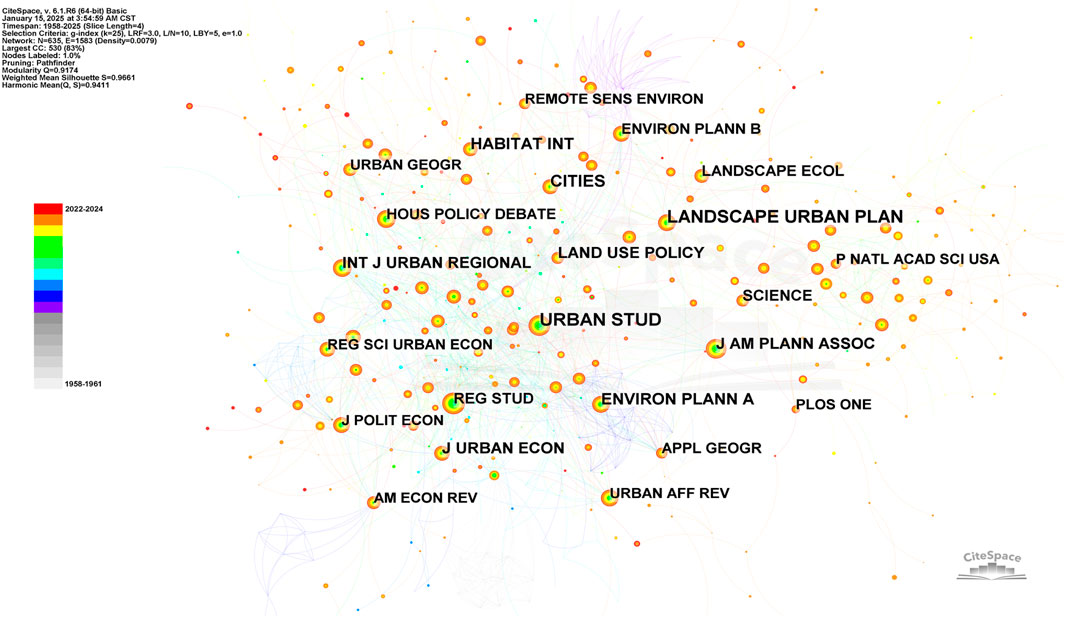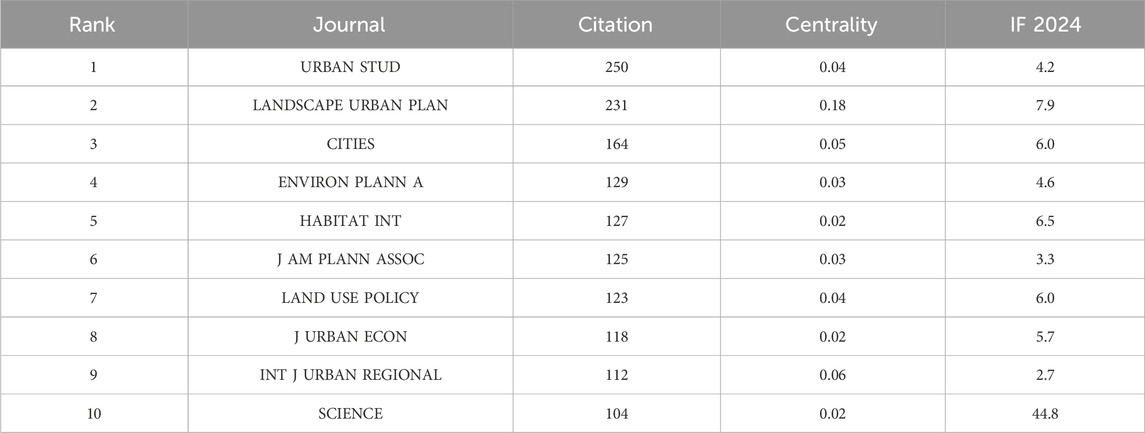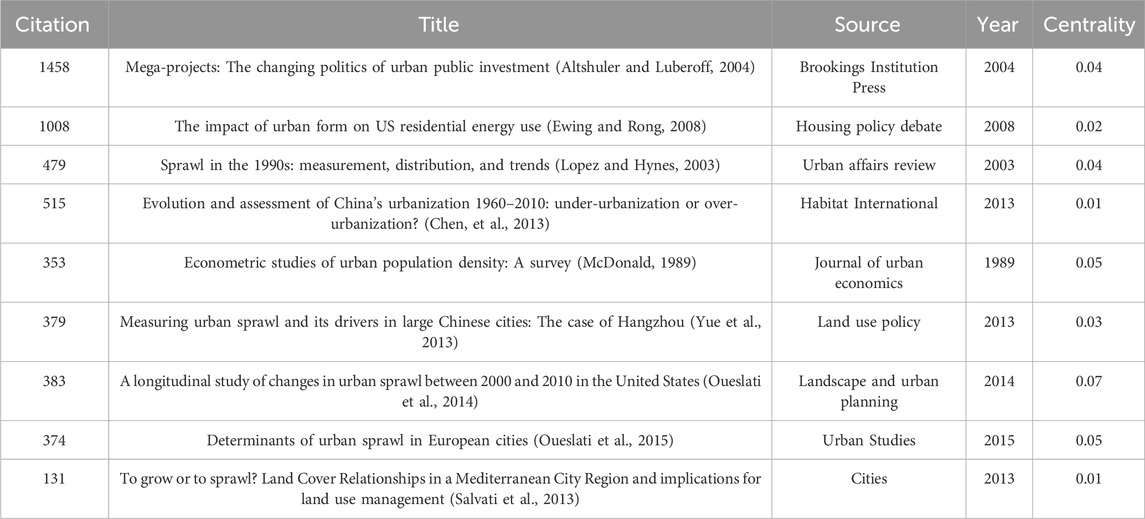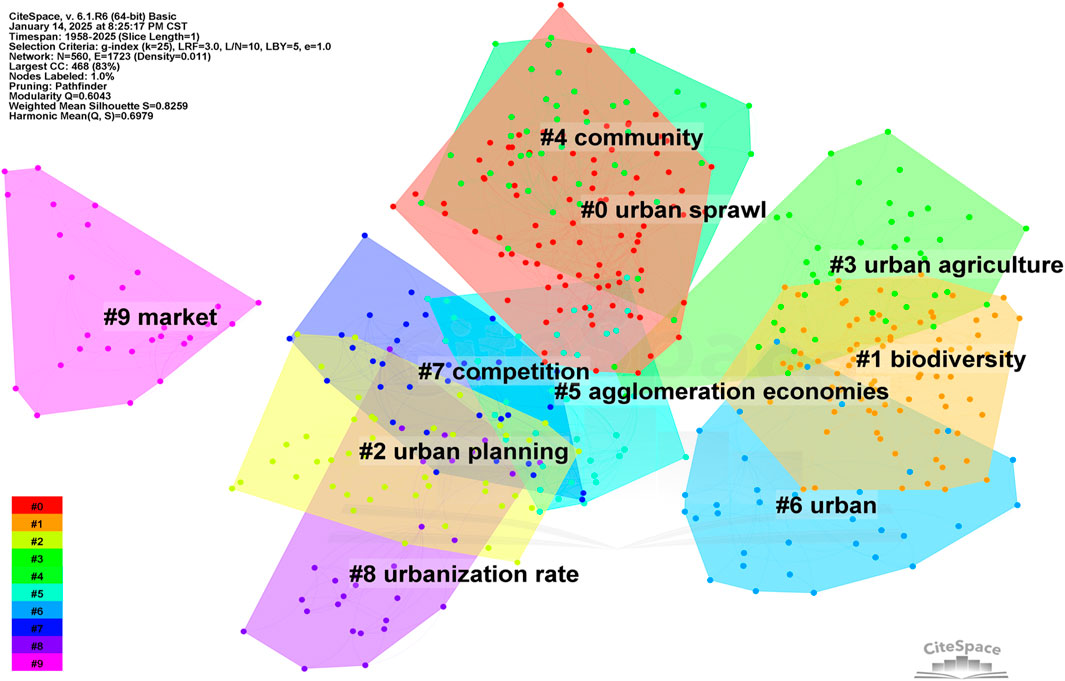- 1School of Public Administration, National Research Center for Resettlement, Hohai University, Nanjing, China
- 2School of Business, Hubei University, Wuhan, China
As global urbanization accelerates, the rapidly growing urban population poses significant challenges to the realization of sustainable development. The Urban Vulnerability–Adaptation–Settlements (VAS) nexus has emerged as a critical research domain to address these challenges. This study conducts a bibliometric analysis of 887 highly cited publications from the Web of Science Core Collection to identify key scholars, research institutions, countries, core research domains, and emerging trends in the field. The findings reveal that: (1) Research related to the Urban VAS nexus can be divided into three developmental phases: the initial budding stage (1958–1991), the high-growth stage (1992–2018), and the stable development stage (2019–2024); (2) Current research primarily focuses on population urbanization, land urbanization, and industrial development, while addressing core issues such as environmental sustainability, social equity, smart governance, and community development; (3) Future research should place greater emphasis on the development of smart cities, green infrastructure, and energy transitions, while also exploring policy innovations and technological advancements to foster a more equitable and sustainable urban future. Based on the finding, this study argues that the key to future urban development lies not in the “speed of growth” but in the “quality of resilience.” Researchers are encouraged to promote multi-scale, multi-dimensional studies of VAS coupling mechanisms, while integrating smart governance, green transitions, and inclusive development goals into urban policy and practice.
1 Introduction
With the acceleration of urbanization, the proportion of the global population residing in cities has steadily increased. According to United Nations data, approximately 30% of the world’s population lived in urban areas in 1950, rising to 55% by 2018, and is projected to surpass 68% by 2050 (Kundu and Pandey, 2020). While urbanization fosters economic growth and social advancement, it also exacerbates challenges such as resource scarcity, land-use conflicts, traffic congestion, and environmental degradation (Onyango, 2018). In response to these issues, scholars have increasingly explored sustainable urban governance models, green infrastructure development, and smart city technologies to enhance urban resilience (Mohanty & Kumar, 2021). Simultaneously, the United Nations Sustainable Development Goals (SDGs) have positioned urban development as a key agenda, advocating for integrated governance strategies to strengthen urban adaptability, reduce social inequalities, and promote environmentally sustainable economic growth (Murayama and Estoque, 2019). In this context, reducing urban vulnerability, enhancing adaptability, and constructing livable urban environments have emerged as critical concerns for scholars and urban policymakers worldwide.
The “Vulnerability–Adaptation–Settlements (VAS) nexus” has increasingly emerged as a focal point in research on climate change and sustainable urban development. This framework emphasizes the vulnerability of urban settlement systems in the face of natural disasters, environmental risks, and socio-economic disruptions, while also highlighting the role of adaptive strategies in enhancing urban resilience and promoting sustainable development in human settlements (Sharifi and Yamagata, 2018). The concept of the VAS Nexus originated from the evolution of urban vulnerability studies. Vulnerability was first introduced in disaster risk assessments during the 1970s and 1980s, focusing on the interplay of social, economic, and environmental factors (Fraser, 2014). In the early 21st century, the United Nations’ Millennium Ecosystem Assessment (2001) broadened the definition of vulnerability, framing it as the degree to which systems are sensitive, exposed, and lack adaptive capacity in the face of external disturbances. More recently, rising attention to climate change has brought increasing academic focus on the interconnections between urban adaptation and settlement development, leading to the formation of the VAS Nexus as a comprehensive conceptual framework (Scott et al., 2024; Han et al., 2024).
Urban vulnerability refers to the degree of exposure and the capacity of urban systems to withstand environmental changes, economic shocks, and social transformations. It is influenced by a wide range of factors, including climate change, ageing infrastructure, socioeconomic inequalities, and weak governance frameworks. In recent years, researchers have increasingly focused on scientifically assessing urban vulnerability to provide policymakers with reliable insights for decision-making (Rözer et al., 2022). Some studies classify urban vulnerability into internal vulnerability (e.g., ecosystem degradation, widening income disparities, and infrastructure deterioration) and external vulnerability (e.g., extreme weather events and global economic fluctuations) (Fraser, 2014). To address these vulnerabilities, scholars have developed various assessment frameworks. For example, the Risk and Hazard (RH) Framework focuses on evaluating the impacts of natural disasters, while the Pressure and Release (PAR) Framework examines how cities respond to economic and social pressures (Sanó, 2011). Additionally, data-driven scenario analysis methods are increasingly being utilized to predict potential risks and provide scientific support for urban planning.
Given the challenges posed by urban vulnerability, enhancing adaptive capacity is crucial. Urban adaptation refers to the strategies cities employ through policy adjustments, infrastructure upgrades, and technological innovations to improve resilience against external shocks. Studies have shown that cities with higher adaptive capacity tend to have effective governance systems, strong social cohesion, and advanced technological support (Tóth and Šebová, 2024). On the governance front, many cities have established comprehensive climate adaptation policies, such as promoting green building initiatives, expanding renewable energy adoption, and optimizing water resource management, all of which contribute to increased environmental resilience (Hamdani and Susanti, 2018). From a technological perspective, smart city innovations play a pivotal role in urban adaptation. For instance, the Internet of Things (IoT) and Artificial Intelligence (AI) facilitate real-time monitoring of air quality, water usage, and infrastructure stability, thereby optimizing urban governance and decision-making (Ho et al., 2022). Moreover, green infrastructure is a key measure for enhancing urban resilience. Initiatives such as urban wetlands, public parks, and rainwater management systems help mitigate flood risks and improve ecosystem services (Acosta-Muñoz et al., 2023). Many cities worldwide are actively exploring these strategies to strengthen their resilience against external disturbances and promote sustainable urban development (Pamukcu-Albers et al., 2021).
The quality of human settlements directly affects public health, safety, and social integration. Human settlements encompass various dimensions, including urban spatial planning, infrastructure development, housing provision, and environmental sustainability, all of which are closely linked to urban resilience (Cirella et al., 2021). Research indicates that rapid urbanization and imbalanced infrastructure development can exacerbate social inequalities and intensify urban vulnerability. For example, low-income communities often face higher exposure to environmental pollution, inadequate housing, and limited access to public services, further increasing their susceptibility to external shocks (Giri et al., 2021). Consequently, urban planning must incorporate sustainable urban design principles that promote compact urban development, reduce urban sprawl, and improve the accessibility of public transportation and green infrastructure. Additionally, equitable housing policies play a crucial role in improving human settlements. Governments should implement land-use regulations and financial support mechanisms to ensure affordable housing for low-income groups, thereby reducing socioeconomic disparities (Smith et al., 2021). Furthermore, promoting green building technologies can contribute to more sustainable urban living environments and reduce energy consumption.
Current research on the Urban Vulnerability–Adaptation–Settlements (VAS) nexus has yielded a number of important findings. To assist scholars in systematically understanding the core research themes, emerging trends, and future directions within this evolving field, this study conducts a comprehensive bibliometric analysis using CiteSpace, based on data from the Web of Science (WoS) Core Collection. The analysis encompasses country-level research distribution, journal publication trends, author collaboration networks, and keyword clustering. The findings aim to provide valuable insights into the practical applications and contributions of the VAS nexus in advancing sustainable urban development, thereby offering scientific guidance and policy references for scholars and decision-makers.
2 Materials and method
2.1 Bibliometric method
Bibliometrics is a quantitative research method that utilizes statistical and computational techniques to analyze and uncover the characteristics, developmental trends, and academic impact of scholarly literature (Patra et al., 2006). The two fundamental theoretical principles of bibliometrics are Bradford’s Law and Lotka’s Law (Xu, 2015). According to Bradford’s Law, the proportion of core journals within a specific research field remains constant relative to the total number of published articles, while the number of non-core journals decreases as their relevance to the core topic diminishes (Saravanan and Aswathy, 2015). Conversely, Lotka’s Law postulates that most scientific publications are produced by a small number of highly prolific scholars or institutions (Pinto et al., 2014).
The bibliometric research process typically includes several key steps: defining the research objective, selecting search terms, retrieving literature from academic databases, collecting and preprocessing bibliographic data, and synthesizing findings into a research report (Patra and Chand, 2006). Various bibliometric tools, such as EndNote, Zotero, and CiteSpace, are commonly employed to facilitate these processes. In this study, CiteSpace is used to conduct bibliometric analysis. CiteSpace is a Java-based visualization software that integrates data mining and information visualization techniques, allowing researchers to explore relationships among scientific publications and analyze the evolution of knowledge structures (Ravikumar and Thankavadivel, 2020). Furthermore, CiteSpace is structured around three core concepts; i) centrality, ii) burst detection, and iii) heterogeneous networks that enhance researchers’ ability to analyze bibliometric relationships (Hussain et al., 2011). Centrality, derived from Social Network Analysis (SNA), measures the importance of a node, such as an author, journal, or keyword, within an academic network. A higher centrality value indicates a more influential role in a research domain or knowledge system (Bailón-Moreno et al., 2005). Burst Detection identifies keywords or research topics that exhibit a sudden surge in citation frequency over a specific period. A high burst index suggests that a keyword has attracted significant scholarly attention within a short time, indicating an emerging or rapidly evolving research trend (Faba-Pérez et al., 2003). Lastly, heterogeneous networks consist of nodes and links, where nodes represent analytical objects such as subject categories, cited authors, cited journals, cited documents, and keywords, while links describe the relationships between these nodes (Jan and Khan, 2012). The research process is illustrated in Figure 1.
2.2 Data acquisition
This study utilizes the WoS as the primary data source and selects “urban development,” “urban vulnerability,” “urban adaptation,” and “human settlements” as search keywords. To ensure data reliability and scholarly rigour, only articles indexed in the WoS Core Collection were considered, with the language restriction set to English. We initially retrieved a total of 359,270 related studies. To better reflect the mainstream trends and core findings of this research field, we selected 887 highly relevant and highly cited representative papers for analysis.
The basic characteristics of the dataset are presented in Table 1. As shown, the majority of the selected publications are journal articles (630 articles, 71.0%), followed by conference proceedings (88 papers, 9.9%), book chapters (53 papers, 6.0%), and book reviews (42 papers, 4.7%). Other document types included proceedings papers, books, editorial materials, editorial material (book chapters), letters, meeting abstracts, notes, reviews, review book chapters, and early access reviews. These diverse document types provide a comprehensive representation of the research landscape within the urban development and sustainability domains.
A preliminary statistical analysis of the selected literature reveals that the publication timeframe spans from January 1958 to December 2024. The dataset comprises 887 scholarly publications, authored by 1,832 researchers affiliated with 1,372 institutions across 57 countries. These studies have been published in 159 academic journals and have accumulated a total of 132,291 citations. Detailed statistical information is presented in Table 2, providing a comprehensive overview of the distribution and impact of the selected research corpus.
2.3 Distribution of publications
An analysis of the bibliometric data retrieved from the WoS indicates that the earliest highly cited publication on the urban VAS nexus appeared in 1958. During the period from 1958 to 1991, the number of highly cited papers in this research domain remained relatively stable, with no more than three publications per year. However, from 1992 to 2018, there was a steady increase in the number of highly cited papers, reflecting the growing academic interest in urban VAS nexus research.
In 2018, the United Nations released the World Urbanization Outlook, which systematically outlined the future trajectory of global urban development. This report highlighted critical challenges associated with climate change, ecological sustainability, and resource carrying capacity, drawing significant scholarly attention to the urban VAS nexus. Following the publication of this report, the number of highly cited papers in this field surged, maintaining a consistent level of over 40 publications per year. The temporal trend of highly cited publications in urban VAS research is illustrated in Figure 2.
3 Results
3.1 Major country analysis of urban development research
The number of highly cited publications and the centrality of different countries in the field of urban VAS research presented in Figure 3. Table 3 provides an overview of the top 10 countries ranked by publication volume. As shown in Table 3, the United States ranks first, with over 200 publications and the highest centrality score, indicating its dominant role in the urban VAS research domain. China follows closely in second place, with 146 publications, a figure comparable to that of the United States and significantly higher than that of England. However, China’s centrality score is lower than that of England, suggesting that while China has made substantial contributions to urban VAS research, it has yet to establish itself as a leading or central influence in the field. Additionally, Australia and Germany exhibit relatively high centrality scores, reaching 0.11 and 0.14, respectively. This suggests that these countries play a crucial role in international academic collaborations and exert considerable influence within the research network. In contrast, the centrality scores of other countries remain below 0.06, indicating that their impact within the global academic collaboration network is relatively limited.
3.2 Author co-citation analysis
When two distinct papers are cited together in other scholarly works, their authors are considered to have a co-citation relationship. Figure 4 illustrates the co-citation network of authors in the field of urban VAS research, while Table 4 lists the top 15 most cited scholars ranked by citation frequency. Overall, “Ewing R,” “Galster G,” and “Brueckner J K” are among the most influential scholars in urban VAS research, with their works being co-cited 80, 65, and 53 times, respectively. Additionally, “Glaeser E L” and “Gordon P” exhibit high centrality scores, reaching 0.22 and 0.18, respectively, indicating that their research holds a prominent position in the urban development field. Their high centrality suggests that their work has significantly shaped the theoretical and empirical discourse in urban VAS studies.
Reid Ewing, George Galster, and Jan K. Brueckner are prominent scholars whose research has significantly influenced the field of urban VAS studies. Reid Ewing is widely recognized for his research on urban sprawl and its implications for sustainable development. His work provides a comprehensive examination of the characteristics, causes, and consequences of urban sprawl, advocating compact city design as a viable alternative for promoting sustainability (Ewing and Hamidi, 2015). George Galster focuses on the dynamics of urban neighborhoods and housing markets, with particular emphasis on spatial inequalities and social vulnerability. His research investigates the intricate relationships between urban form, socio-economic disparities, and spatial segregation, shedding light on how urban planning and policy interventions can help reduce urban vulnerability and foster equitable human settlements (Galster, 2013). Brueckner (2000) is a leading figure in the economic analysis of urban sprawl and land use. His research explores the economic forces driving urban expansion, examining their implications for resource allocation and environmental sustainability.
3.3 Journal co-citation analysis
When two papers published in different journals are simultaneously cited by a third paper, the two journals are considered co-cited journals. Figure 5 illustrates the co-citation network of journals in the field of urban VAS research, while Table 5 presents the top 10 most co-cited journals ranked by citation frequency.
As shown in Table 5, the majority of urban development-related studies are published in Urban Studies and Landscape and Urban Planning. Furthermore, Cities and the International Journal of Urban and Regional Research exhibit relatively high centrality scores, reaching 0.05 and 0.06, respectively. This suggests that these journals play a leading role in shaping research within the field of urban studies. Urban Studies primarily focuses on urbanization and urban processes, covering a wide range of topics, including urban development, urban planning, urban policy, urban sociology, urban geography, urban economics, and urban environmental studies. Similarly, Landscape and Urban Planning is dedicated to research on urban and landscape design, with an emphasis on the natural environment and human wellbeing. Additionally, Cities and International Journal of Urban and Regional Research are highly influential international journals that encompass a broad spectrum of research areas, including urban planning and design, urban sustainability, and urban history and culture. Their high centrality scores indicate their significant academic influence and widespread recognition within the urban development and sustainability research communities.
3.4 Literature co-citation analysis
When two papers are cited together in another publication they are considered co-cited. Co-citation analysis enables the identification of key literature within a specific research domain, facilitating the exploration of foundational studies and emerging trends. Table 6 presents the top ten highly cited and high-centrality publications in the urban VAS research field. Notably, the majority of these papers are published in the journals listed in Table 5. Among these ten highly cited papers, six focus on the driving factors of urban expansion and the ecological, environmental, and social challenges associated with this process. Additionally, three papers examine the impact of population urbanization on economic growth, energy consumption, and community development. The remaining paper investigates the influence of urban industrial development on economic transformation and the socio-environmental landscape. These findings highlight the three core research areas within the urban VAS nexus: land urbanization (Land Urbanization), population urbanization (Population Urbanization), and urban industrial development (Urban Industrial Development). These themes represent the fundamental dimensions of urban transformation, shaping scholarly discourse on urban sustainability and resilience (Kumar et al., 2024).
Urban development is fundamentally driven by industrialization, particularly the emergence of new industries spurred by technological advancements (Barras, 1987). Industrialization not only fosters economic growth but also reshapes urban structures by attracting labor migration, increasing population density, and expanding urban land use (Zhang et al., 2018). One of the most significant impacts of industrialization is population urbanization, which refers to the migration of rural populations to urban areas in search of better employment opportunities (Bairoch and Goertz, 1986). This migration is primarily driven by the demand for labor in industrial centers, which not only accelerates urban population growth but also alters local socio-economic structures. For example, studies on China’s rapid urbanization reveal that industrial expansion and labor market liberalization led to large-scale rural-to-urban migration, fundamentally transforming employment patterns and urban infrastructure demands (Shangguan, 2024a). Simultaneously, land urbanization—the conversion of rural land for urban purposes—is closely linked to industrialization (He et al., 2016). As industries develop, the demand for factories, residential areas, and commercial hubs significantly increases, leading to major shifts in land use patterns. Research has demonstrated that for every 1% increase in population urbanization, urban construction land expands by approximately 0.87%, illustrating the direct correlation between industrialization, demographic shifts, and land consumption (Chen et al., 2008). Beyond population and land urbanization, industrial restructuring plays a critical role in shaping urban development (Wu, 2020). Economic transitions, such as the shift from manufacturing to service-based industries, directly influence urban spatial planning, infrastructure development, and environmental sustainability. Studies have shown that cities undergoing industrial transitions often experience shifts in employment distribution, land-use policy modifications, and economic productivity changes, further impacting their social, economic, and environmental landscapes (Qu and Long, 2018). In conclusion, population urbanization, land urbanization, and industrial development form the core research domains of the urban VAS nexus. These factors are interconnected and serve as key indicators for assessing urban development. Understanding their interactions provides valuable insights into urban sustainability, economic planning, and environmental resilience, guiding policymakers and urban planners in developing adaptive strategies for future urban expansion.
3.5 Cluster analysis
Keywords encapsulate the core content of a study and serve as indicators of the fundamental directions within a research domain. Consequently, conducting a knowledge mapping analysis of keywords is instrumental in identifying key research areas. Figure 6 presents the visualized keyword clustering network, providing a structured representation of thematic clusters. Within the comprehensive network, the modularity Q value reaches 0.6043, indicating a high degree of clustering significance. Simultaneously, the average silhouette score of 0.8259 suggests strong internal consistency among the primary clusters. As depicted in Figure 5, the network comprises ten key clusters. Table 7 outlines each cluster’s ID, size, silhouette score, label, and average citation year.
In Figure 5, it is evident that Cluster #0 (Urban Sprawl), Cluster #8 (Urbanization Rate), and Cluster #9 (Market) exhibit no direct intersections. These three clusters correspond to the three primary evaluation indicators of urban development: Land Urbanization, Population Urbanization and Industrial Development. This finding further reinforces the notion that land urbanization, population urbanization, and industrial development constitute critical domains in urban development research. Additionally, the results align with the co-citation analysis presented in Section 3.5, confirming the interconnectedness of these key research areas. A detailed analysis of the keywords within these three clusters reveals distinct thematic focuses: urban sprawl (cluster #0) involves land-use policy, water balance, sustainable development, urban expansion, urban growth, land use planning, and urban land use policy; 2) urbanization rate (cluster #8) involves urban land use policy, land hoarding, land use planning, urban growth, urban sprawl, urban morphology, urban intensification, urban sustainability, and environmental change; 3) market (cluster #9) involves network, labor, society, demand fluctuation, urban industrial, real estate, industrial clustering, spatial distribution analysis, industrial district, etc.
Additionally, Cluster #6 (Urban) emerges as a broader conceptual category and does not directly intersect with Cluster #0 (Urban Sprawl), Cluster #8 (Urbanization Rate), or Cluster #9 (Market). Further examination of its keywords suggests that Cluster #6 (Urban) encompasses fundamental attributes and elements of cities, which are extensively explored in urban VAS core research areas. These include: occupancy, neighborhood, geography, gender, identity, ecology, environment, and food. Overall, research within the urban VAS nexus extends across multiple dimensions, encompassing economic development, spatial transformation, social structures, cultural influences, ecology, and environmental sustainability.
3.6 Keywords burst citation
Table 8 presents keywords that have exhibited significant citation bursts across different periods, thereby revealing the evolutionary trajectory of research themes within the urban VAS domain. In the visualization, deep blue bars represent the entire research period, while red bars indicate the timeframes in which keywords experienced citation bursts. Among the key themes in urban VAS research, “Environmental Pollution” has exhibited the longest research cycle, spanning from 2000 to 2024, with a notable citation burst occurring between 2002 and 2008. This suggests that since the early 21st century, environmental concerns have consistently remained a core focus in urban VAS studies. Following the prominence of environmental pollution research, “Ecological Protection” emerged as a key topic, experiencing a citation burst between 2011 and 2017. Subsequently, research related to “Equality,” “Welfare,” and “Community Development” gained academic attention, with each theme becoming a research hotspot at different stages. Notably, research on “Equality” witnessed a decline in citation bursts after 2019, whereas studies on “Welfare” and “Community” are projected to continue receiving substantial scholarly attention through 2024.
This trend highlights the progression of urban VAS research themes—from an initial emphasis on environmental protection to a growing focus on social welfare, equity, and community development. It underscores the increasing recognition of socio-environmental integration in urban studies, emphasizing the critical role of sustainability, social justice, and community wellbeing in the ongoing discourse on urban development.
4 Discussion
In Sections 3.4, 3.5, integrating software-based analytical results with existing literature, we conclude that Population Urbanization, Land Urbanization, and Industrial Development constitute the core research domains of urban VAS studies. Meanwhile, in Section 3.6, findings indicate that Environment, Ecology, Social Welfare, Equity, and Community are emerging as key research hotspots within the urban VAS framework. Building on these insights, this study further conducts a comprehensive literature review of the core research domains of the hotspots. Additionally, we aim to identify gaps in the existing research and propose future research directions, offering a deeper understanding of the evolving landscape of urban VAS studies.
4.1 Impact of population urbanization, land urbanization and industrial development on ecological environment
The impact of population urbanization, land urbanization and industrial development on the ecological environment is complex and mixed (Zhao et al., 2024; Nahid et al., 2025). In terms of population urbanization and land urbanization, their influence on the ecological environment maintained three mainstream views: First, building on the population aggregation effect, some scholars believe that population urbanization and land urbanization will reduce environmental pollution. Scholars holding this opinion believe that the spatial aggregation effect of human activities caused by population urbanization and land urbanization will help to reduce the distance of people’s economic activities and the energy consumption of transportation commuting (Li et al., 2021; Bi, 2015). In addition, this spatial aggregation effect will also be conducive to the output and promotion of scientific and technological achievements, such as the design of smart cities and sponge cities, which will further reduce environmental pollution (Tao et al., 2023). Second, there are certain numbers of scholars who believe that population urbanization and land urbanization will significantly increase environmental pollution. This opinion has been generally confirmed as the truth that air pollution, water pollution, and climate change are directly caused by the increase of urban industries, buildings and transportation facilities Shangguan. (2024b). The main reason for the difference between the above two opinions is the neglect of the time effect. This can be well explained by the environmental Kuznets curve, that is, in the short-term population urbanization and land urbanization will promote the growth of environmental pollution, which is due to a certain lag in the science and technology development. However, as society, economy and technology reach a certain stage, population urbanization and land urbanization will reduce environmental pollution. Therefore, the third views indicate that the relationship between urbanization (population urbanization and land urbanization) and environmental pollution presents an inverted U-shaped curve, which is widely confirmed by scholars globally (Fan and Zhou, 2019; Sadorsky, 2014; Shangguan, 2024b).
While, when the impact of industrial development on the ecological environment is studied, the impact of industrial structure rationalization, industrial structure advancement, industrial agglomeration and industrial synergy on the ecological environment has been widely discussed, and the commonly used theories include the economic aggregation effect and the environmental Kuznets curve. Zhu et al. (2019) concluded that both industrial structure rationalization and industrial structure advancement have positive impacts on the ecological environment, and the later plays a greater role. Guo et al. (2020) investigated the impact of industrial agglomeration on the ecological environment and found a U-shaped relationship between them in northeast China from 2003 to 2016. Dong et al. (2021) analyzed the spatial dependence between industrial synergy and the ecological environment and concluded that the higher the degree of industrial integration, the better the ecological environment. Ding et al. (2022) further verified Dong et al.'s conclusion, and they also argued the leading role of productive service and manufacturing industries in the sustainable development of the ecological environment.
At present, theoretical research on the impacts of population urbanization, land urbanization, and industrial development on the ecological environment has reached a bottleneck. With the United Nations actively promoting energy transition and green development, future studies should explore how these approaches can mitigate the environmental challenges brought about by urbanization. Potential directions include: (1) increasing the share of green energy to reduce carbon footprints; (2) leveraging green finance to promote investment in green infrastructure; (3) enhancing urban energy efficiency to achieve green economic growth; and (4) strengthening the participation of local governments and the public to ensure sustainable governance.
4.2 Impact of population urbanization, land urbanization and industrial development on social equity and welfare
The impact of population urbanization, land urbanization and industrial development on social equity and welfare has both positive and negative aspects. From a positive perspective, population urbanization, land urbanization and industrial development would increase social welfare and promote social equity. According to human capital theory, population urbanization can improve people’s opportunities for education, skill training and employment, which in turn increases income and social welfare levels (Nafukho et al., 2004). As the urban population continues to grow, governments usually invest more resources to improve the city’s infrastructure and public services, such as building better roads, parks, hospitals and schools. These improvements can provide better services and higher social welfare for citizens (Xu, 2004). In terms of land urbanization, Locke and Henley found that land urbanization can reduce poverty, because these newly urbanized areas will enjoy the economic radiation of the urban city (Locke and Henley, 2016). Compared with population urbanization and land urbanization, the impact of industrial development on poverty is more obvious and direct. As Ravallion points out, industrial development can provide more employment opportunities and increase the basic wage level, resulting in a reduction of poverty for more people (Ravallion, 2002).
From a negative perspective, the process of population urbanization, land urbani-zation, and industrial development may exacerbate the urban-rural gap and widen the wealth disparities within society. The urban sprawl hypothesis holds that population urbanization leads to inequality between and within cities (Brueckner and Fansler, 1983). This phenomenon is more obvious among cities because developed cities usually attract more resources and talent, which leads to resource scarcity and population reduction in poor areas; similarly, within cities, the gap between urban and rural areas is widening (DeSalvo and Su, 2019). The impact of land urbanization on social equity and welfare is mainly manifested in the distribution of social and natural resources (Wei and Ewing, 2018). However, these resources are easily monopolized by the government or large enterprises. The land finance caused by the government monopoly will lead to certain corruption (Chiweshe, 2021); however, when enterprises control land, it is easy to ignore the interests of vulnerable groups because they seek to maximize the interests (Shen and Hannah, 2012). Urban industrial development generally improves social welfare because it is constrained by market supply and demand (Ravallion, 2002). However, in the extreme development of industries such as housing bubbles and market monopolies, the income level and social welfare of urban residents will deteriorate overall (Myers and Talarico, 1986). In addition, the siphon effect of industrially developed regions will further widen the wealth gap between developed regions and developing regions (Niravita, 2020).
Current research on the impacts of urbanization and industrial development on social equity and welfare tends to focus primarily on the macro level. However, the micro-level social challenges they generate—particularly for vulnerable populations—remain critically important. As urbanization accelerates, social resources often become increasingly concentrated among high-income groups, resulting in disparities for vulnerable populations such as low-income individuals, children, the elderly, people with disabilities, and migrant communities. These groups frequently face inequalities in access to housing, transportation, healthcare, education, and green spaces. Future research should address these challenges from several key perspectives: (1) how to accurately identify the needs and spatial distribution of vulnerable groups; (2) how to assess and improve the equity of urban basic services; (3) how to promote participatory governance; and (4) how to integrate social welfare policies with urban design.
4.3 Impact of population urbanization, land urbanization and industrial development on community development
The relationship between urbanization and community development is influenced by community governance, public services, economic structures, and environmental sustainability. While urbanization fosters economic growth, infrastructure improvement, and community expansion, it also introduces challenges related to social inequality, environmental degradation, and resource allocation.
Existing research highlights the transformative role of population urbanization in community governance and service provision. The clustering of research and development (R&D) professionals in urban areas enhances community management efficiency by promoting public participation, transparency, and innovation in governance models (Speer, 2012; Atkinson and Zimmermann, 2018). However, this process is often gradual and uneven, particularly in-migrant communities, where cultural differences and social tensions may slow adaptation (Perulli, 2016). Another key impact of population urbanization is its role in expanding the tertiary sector, which significantly influences community services. The integration of service industries with healthcare, education, and housing has shifted community service provision from state-driven models to market-oriented and socially managed frameworks, thereby improving service efficiency and quality of life (Vlahov and Galea, 2002; O’brien et al., 2005). However, concerns remain regarding potential threshold effects, where the marginal benefits of population urbanization on community services diminish beyond a certain point, requiring further empirical investigation.
Land urbanization plays a crucial role in shaping community structures, impacting public service accessibility, residential patterns, and socioeconomic interactions. One perspective argues that land urbanization enhances community wellbeing by expanding educational, healthcare, and recreational facilities, thereby improving residents’ quality of life (Rydin and Pennington, 2000). Furthermore, urban land expansion facilitates improved infrastructure, including public transport, utilities, and green spaces, which contribute to community connectivity and social integration (Wu, 2006). However, land urbanization also presents significant risks, particularly regarding land conversion and resource scarcity. The large-scale transformation of agricultural land into urban infrastructure and housing has led to food security concerns, displacement of rural communities, and economic instability (Jarah et al., 2019; Bonye et al., 2021). These issues are particularly pronounced in developing countries, where peri-urban communities struggle to access both agricultural and urban resources (Long et al., 2021). Additionally, rapid suburban expansion has disrupted agricultural communities, leading to job losses, forced migration, and declining social cohesion (Mera, 2015).
Industrial development is a key driver of urban growth, fostering economic expansion, employment opportunities, and improved living conditions. From an economic perspective, industrial agglomeration attracts labor inflows, contributing to demographic growth and economic diversification (Zhao, et al., 2014). Moreover, industrial development strengthens community resilience by generating stable employment and improved infrastructure, facilitating socioeconomic mobility (Kazak, et al., 2014). Conversely, industrial expansion—particularly in heavy industries and high-pollution sectors—poses environmental and health risks to communities. The concentration of polluting industries leads to air and water contamination, noise pollution, and deteriorating living conditions, negatively affecting public health and urban livability (White and Guest, 2003). Furthermore, industrial land use patterns often exacerbate spatial inequality, where low-income communities bear a disproportionate burden of environmental hazards and infrastructure deficiencies.
Future research should explore adaptive urban planning strategies that integrate technological innovations, participatory governance models, and sustainable infrastructure solutions. With the rise of smart technologies, big data, and the IoT, cities are becoming increasingly digitized, offering new pathways for community resilience and urban adaptation. Therefore, future research can proceed from the following key directions: (1) integrating smart governance with participatory planning; (2) strengthening the resilience of urban infrastructure; (3) fostering “smart citizens” and enhancing community self-organization capabilities; (4) integrating the concepts of “smart cities” and “resilient cities” to promote an urban adaptation framework that balances technological innovation with social inclusion.
4.4 Challenges related to the urban vulnerability-adaptation-human settlements nexus
The Urban VAS Nexus presents significant challenges that impact sustainable urban development, requiring multidimensional governance approaches and integrated planning frameworks. These challenges stem from the complex interactions between environmental, economic, and social factors, which influence urban resilience, adaptation capacity, and human wellbeing (Adger, 2006). One of the primary challenges within the VAS nexus is the increasing exposure of urban areas to environmental risks, including climate change, extreme weather events, and ecological degradation. Rapid urbanization and industrialization have led to higher levels of air and water pollution, biodiversity loss, and increased vulnerability to natural disasters (Revi et al., 2014). The displacement of natural ecosystems due to land urbanization has further exacerbated urban heat island effects, flooding risks, and water resource depletion (Seto et al., 2012). These environmental vulnerabilities not only threaten human settlements but also challenge urban adaptation policies, as cities struggle to implement sustainable land-use planning and resilient infrastructure (Pelling and Blackburn, 2013). In this context, the integration of green infrastructure—such as urban forests, permeable surfaces, and nature-based stormwater systems—can help buffer environmental shocks and reduce urban vulnerability.
Another critical issue is the socioeconomic disparity that accompanies urbanization and industrial development. While land urbanization and industrial expansion generate economic growth, they also contribute to social inequalities, housing shortages, and displacement of low-income populations (Satterthwaite, 2020). The process of population urbanization often leads to gentrification and the marginalization of vulnerable communities, limiting their access to adequate housing, healthcare, and employment opportunities (McGranahan et al., 2016). Moreover, the growing reliance on market-driven community service models has led to unequal access to essential urban services, further exacerbating disparities in living conditions and wellbeing (Anguelovski et al., 2018). Adopting smart city technologies, such as spatial mapping of service accessibility, real-time data monitoring, and AI-driven urban service optimization, can support more equitable planning and enhance service delivery to underserved populations.
Governance challenges also remain a critical barrier to addressing urban vulnerability and adaptation. Many cities lack integrated governance frameworks that effectively balance economic development, environmental protection, and social equity (Bulkeley, 2013). Fragmented policies and inadequate coordination among local governments, private sectors, and civil society hinder the implementation of holistic adaptation strategies (Romero-Lankao et al., 2018). Additionally, the transition toward “smart communities” and digital governance models has introduced both opportunities and risks, as cities struggle to integrate big data, AI, and the Internet of Things (IoT) into urban planning and resilience-building efforts (Kitchin, 2015). To address these challenges, future research should focus on developing interdisciplinary strategies that bridge the gap between urban vulnerability, adaptation, and human settlements. Efforts should be directed toward enhancing resilience through green infrastructure, adaptive governance mechanisms, and community-based adaptation models (Meerow and Newell, 2019). To strengthen the nexus between urban resilience and sustainability, energy transition strategies such as distributed renewable energy systems, energy-efficient infrastructure, and smart grids should be incorporated into urban planning to reduce emissions and enhance adaptive capacity, particularly in vulnerable neighborhoods.
The convergence of smart technologies, ecological design, and clean energy systems provides a promising pathway for building urban environments that are both resilient and inclusive. Additionally, fostering inclusive urban policies that prioritize social equity and sustainable development will be essential in mitigating the long-term risks associated with the urban VAS nexus.
5 Conclusion
This study employed bibliometric analysis the Urban Vulnerability–Adaptation–Settlements (VAS) Nexus from the WoS database, covering the period from 1985 to 2025. The findings indicate that research in this field has evolved through three main phases: the budding period (1958–1991), the high growth period (1992–2018), and the stable development phase (since 2019). Geographically, the United States, China, and the United Kingdom have emerged as key contributors, with scholars such as Ewing R, Galster G, and Brueckner Jk playing influential roles. Key journals including Urban Studies, Landscape and Urban Planning, and Cities serve as primary platforms for publishing on urban history, environmental planning, and urban economics.
Current research primarily focuses on population urbanization, land urbanization, and industrial development, while addressing critical themes such as environmental sustainability, social equity, smart governance, and community development. Future research should place greater emphasis on the integration of low-carbon technologies and green infrastructure to mitigate the environmental challenges posed by urban expansion and industrialization. At the same time, ensuring the social equity and wellbeing of vulnerable groups—particularly in areas such as housing security, employment opportunities, and access to basic services—remains essential. These research priorities directly contribute to achieving the United Nations SDGs.
The application of smart city technologies such as big data, AI, and the IoT presents new opportunities to enhance urban governance, optimize infrastructure management, and improve disaster response. Adaptive urban planning and the implementation of green infrastructure will also be vital to building urban resilience in the face of climate change and shifting population dynamics. Achieving these goals requires interdisciplinary collaboration across the social, economic, environmental, and technological domains to design effective policies and innovative solutions. Aligning urban transformation strategies with the SDGs can ensure that cities are not only resilient but also inclusive, climate-responsive, and socially just. Based on these findings, the following recommendation has been made:
• Researchers to advance multi-scale VAS nexus studies, develop high-resolution assessment tools, and support precision-based urban adaptation.
• Policymakers to integrate smart governance, green transition, and inclusive development into urban policies with targeted regulations and incentives.
• Urban planners to incorporate green infrastructure, energy transitions, and community participation, shifting from engineering-based to socio-ecological resilience.
Data availability statement
The raw data supporting the conclusions of this article will be made available by the authors, without undue reservation.
Author contributions
JJ: Writing – review and editing, Conceptualization, Writing – original draft, Resources, Formal Analysis, Data curation. DC: Methodology, Writing – review and editing, Conceptualization, Project administration, Formal Analysis, Writing – original draft. QY: Resources, Project administration, Writing – review and editing, Methodology, Investigation, Writing – original draft. MH: Conceptualization, Writing – review and editing, Funding acquisition, Visualization.
Funding
The author(s) declare that financial support was received for the research and/or publication of this article. This work was supported by the Open Fund Project of Key Research Bases of Humanities and Social Sciences for Universities in Hubei Province (No. 2022KFJJ04); Hubei Provincial Federation of Social Sciences Post-Funded Project (HBSKJJ20243266); Ministry of Education Humanities and Social Sciences Youth Fund Project (24YJC790065).
Conflict of interest
The authors declare that the research was conducted in the absence of any commercial or financial relationships that could be construed as a potential conflict of interest.
Generative AI statement
The author(s) declare that Generative AI was used in the creation of this manuscript. The author(s) verify and take full responsibility for the use of generative AI in the preparation of this manuscript. Generative AI was used polish the language.
Publisher’s note
All claims expressed in this article are solely those of the authors and do not necessarily represent those of their affiliated organizations, or those of the publisher, the editors and the reviewers. Any product that may be evaluated in this article, or claim that may be made by its manufacturer, is not guaranteed or endorsed by the publisher.
References
Acosta-Muñoz, M. D., Flores-Lucero, M. L., and Guevara-Romero, M. L. (2023). Environmental improvement to reduce urban vulnerability in irregular settlements. Rev. Ing. Civ. 7 (17). doi:10.35429/JCE.2023.17.7.1.9
Adger, W. N. (2006). Vulnerability. Glob. Environ. Change 16 (3), 268–281. doi:10.1016/j.gloenvcha.2006.02.006
Altshuler, A. A., and Luberoff, D. E. (2004). Mega-projects: the changing politics of urban public investment. Rowman and Littlefield. Brookings Institution Press.
Anguelovski, I., Connolly, J. J. T., Masip, L., and Pearsall, H. (2018). Assessing green gentrification in historically disinvested neighborhoods: a longitudinal and spatial analysis of Barcelona. Landsc. Urban Plan. 178, 102–113. doi:10.1080/13549839.2018.1440744
Assessment, M. E. (2001). Millennium ecosystem assessment, 2. Washington, DC, USA: Millennium Ecosystem Assessment.
Atkinson, R., and Zimmermann, K. (2018). “Area-based initiatives–a facilitator for participatory governance?,” in Handbook on participatory governance. Cheltenham, UK: Edward Elgar Publishing, 267–290.
Bailón-Moreno, R., Jurado-Alameda, E., Ruiz-Baños, R., and Courtial, J. (2005). Bibliometric laws: empirical flaws of fit. Scientometrics 63, 209–229. doi:10.1007/s11192-005-0211-5
Bairoch, P., and Goertz, G. (1986). Factors of urbanisation in the nineteenth century developed countries: a descriptive and econometric analysis. Urban Stud. 23 (4), 285–305. doi:10.1080/00420988620080351
Barras, R. (1987). Technical change and the urban development cycle. Urban Stud. 24 (1), 5–30. doi:10.1080/00420988720080021
Bi, X. H. (2015). Research on the mechanism of urbanization’s impact on carbon emission. Shanghai Econ. Re-search 10, 97–106. doi:10.19626/j.cnki.cn31-1163/f.2015.10.011
Bonye, S. Z., Yiridomoh, G. Y., and Derbile, E. K. (2021). Urban expansion and agricultural land use change in Ghana: implications for peri-urban farmer household food security in Wa municipality. Int. J. Urban. Sustain 13 (2), 383–399. doi:10.1080/19463138.2021.1915790
Brueckner, J. K. (2000). Urban sprawl: diagnosis and remedies. Int. Regional Sci. Rev. 23 (2), 160–171. doi:10.1177/016001700761012710
Brueckner, J. K., and Fansler, D. A. (1983). The economics of urban sprawl: theory and evidence on the spatial sizes of cities. Rev. Econ. Stat. 65, 479–482. doi:10.2307/1924193
Chen, H., Jia, B., and Lau, S. S. Y. (2008). Sustainable urban form for Chinese compact cities: challenges of a rapid urbanized economy. Habitat Int. 32 (1), 28–40. doi:10.1016/j.habitatint.2007.06.005
Chen, M., Liu, W., and Tao, X. (2013). Evolution and assessment on China's urbanization 1960–2010: under-urbanization or over-urbanization? Habitat Int. 38, 25–33. doi:10.1016/j.habitatint.2012.09.007
Chiweshe, M. K. (2021). “Urban land governance and corruption in africa,” in Land issues for urban governance in Sub-Saharan Africa. Local and urban governance. Editor R. Home (Cham, Germany: Springer), 225–236.
Cirella, G., Mwangi, S. W., Streltsova, K., Abebe, S. T., and Russo, A. (2021). Human settlements: urban challenges and future development. Springer Nature.
DeSalvo, J. S., and Su, Q. (2019). The determinants of urban sprawl: theory and estimation. Int. J. Urban Sci. 23, 88–104. doi:10.1080/12265934.2018.1452627
Ding, J., Liu, B., and Shao, X. (2022). Spatial effects of industrial synergistic agglomeration and regional green development efficiency: evidence from China. Energ. Econ. 112, 106156. doi:10.1016/j.eneco.2022.106156
Dong, F., Li, Y., Qin, C., and Sun, J. (2021). How industrial convergence affects regional green development efficiency: a spatial conditional process analysis. J. Environ. Manage. 300, 113738. doi:10.1016/j.jenvman.2021.113738
Ewing, R., and Hamidi, S. (2015). Compactness versus sprawl: A review of recent evidence from the United States. J. Plan. Litera. 30 (4), 413–432. doi:10.1177/0885412215595439
Ewing, R., and Rong, F. (2008). The impact of urban form on US residential energy use. Hous. policy debate 19 (1), 1–30. doi:10.1080/10511482.2008.9521624
Faba-Pérez, C., Guerrero-Bote, V. P., and Moya-Anegón, F. (2003). “Sitation” distributions and Bradford's law in a closed Web space. J. Documentation 59, 558–580. doi:10.1108/00220410310499582
Fan, J. S., and Zhou, L. (2019). Study on the mechanism and effect of urbanization and real estate investment on carbon emissions in China. Sci. Geogr. Sin. 39, 644–653. doi:10.13249/j.cnki.sgs.2019.04.014
Fraser, A. (2014). Rethinking urban risk and adaptation: the politics of vulnerability in informal urban settlements (Doctoral dissertation, London. School of Economics and Political Science).
Galster, G. (2013). Neighborhood social mix: Theory, evidence, and implications for policy and planning. Policy, planning, and people: Promoting justice in urban development. 308–336. doi:10.9783/9780812207965.307
Giri, M., Bista, G., Singh, P., and Pandey, R. (2021). Climate change vulnerability assessment of urban informal settlers in Nepal, a least developed country. J. Clean. Prod. 307, 127213. doi:10.1016/j.jclepro.2021.127213
Guo, Y., Tong, L., and Mei, L. (2020). The effect of industrial agglomeration on green development efficiency in North-east China since the revitalization. J. Clean. Prod. 258, 120584. doi:10.1016/j.jclepro.2020.120584
Hamdani, A., and Susanti, N. E. (2018). Examining the level of vulnerability and adaptation of middle-class urban communities to climate change. Environ. Sci. Sociol., 36–40. doi:10.5220/0007414700360040
Han, Q., Kumar, R., and Kumar, A. (2024). Climate change and human migration: perspectives for environmentally sustainable societies. J. Geochem. Explor. 256, 107352. doi:10.1016/j.gexplo.2023.107352
He, C., Chen, T., Mao, X., and Zhou, Y. (2016). Economic transition, urbanization and population redistribution in China. Habitat Int. 51, 39–47. doi:10.1016/j.habitatint.2015.10.006
Ho, S., Baptista, M. D., and McEvoy, D. (2022). Community profiling to support inclusive urban community-based climate adaptation: experiences of a survey-based approach in urban informal settlements in honiara, Solomon Islands. Clim. Dev. 15, 325–339. doi:10.1080/17565529.2022.2083547
Hussain, A., Fatima, N., and Kumar, D. (2011). Bibliometric analysis of the electronic library journal. Webology. 8 (1), 87
Jarah, S. H. A., Zhou, B., Abdullah, R. J., Lu, Y. W., and Yu, W. T. (2019). Urbanization and urban sprawl issues in city structure: a case of the Sulaymaniah Iraqi Kurdistan region. Sustainability 11 (2), 485. doi:10.3390/su11020485
Jan, S. A. S. U., and Khan, F. (2012). Lotka’s law of scientific productivity: Theory and application. PUTAJ-Humani. Soci. Sci. 19 (1).
Kazak, J., Szewranski, S., and Decewicz, P. (2014). “Holistic assessment of spatial policies for sustainable management: case study of wroclaw larger urban zone (Poland),” in Geodesign by integrating design and geospatial sciences (Cham, Switzerland: Springer), 71–85.
Kitchin, R. (2015). Making sense of smart cities: addressing present shortcomings. Camb. J. Regions, Econ. Soc. 8 (1), 131–136. doi:10.1093/cjres/rsu027
Kumar, R. P., Singh, R., Kumar, P., Kumar, R., Nahid, S., Singh, S. K., et al. (2024). Aerosol-PM2. 5 Dynamics: in-situ and satellite observations under the influence of regional crop residue burning in post-monsoon over Delhi-NCR, India. Environ. Res. 255, 119141. doi:10.1016/j.envres.2024.119141
Kundu, D., and Pandey, A. (2020). World urbanisation: trends and patterns. Dev. Natl. Urban Policies, 13–49. doi:10.1007/978-981-15-3738-7_2
Li, Z. G., Wang, J., and Che, S. (2021). Spatial emission reduction effect of land urbanization advancement: intrinsic mechanism and Chinese experience. Stat. Res. 38, 89–104. doi:10.19343/j.cnki.11-1302/c.2021.12.007
Locke, A., and Henley, G. (2016). Urbanisation, land and property rights, ODI report. London, UK: Overseas Development Institute.
Long, H. L., Kong, X. B., Hu, S. G., and Li, Y. R. (2021). Land use transitions under rapid urbanization: a perspective from developing China. Land 10, 935. doi:10.3390/land10090935
Lopez, R., and Hynes, H. P. (2003). Sprawl in the 1990s: measurement, distribution, and trends. Urban Aff. Rev. 38 (3), 325–355. doi:10.1177/1078087402238805
McDonald, J. F. (1989). Econometric studies of urban population density: a survey. J. urban Econ. 26 (3), 361–385. doi:10.1016/0094-1190(89)90009-0
McGranahan, G., Schensul, D., and Singh, G. (2016). Inclusive urbanization: can the 2030 Agenda be delivered without it? World Dev. 88, 213–224. doi:10.1016/j.worlddev.2016.05.016
Meerow, S., and Newell, J. P. (2019). Urban resilience for whom, what, when, where, and why? Glob. Environ. Change 56, 101946. doi:10.1016/j.gloenvcha.2019.101946
Mera, A. (2015). “Effects of urban sprawl on the livelihood of suburban agricultural community: the case of Sara Ampol, Yeka Tafo and Chorizo area, Yeka sub city, Addis Ababa (Ethiopia),”. Masters thesis (Addis Abeba: Addis Ababa University). Available online at: http://thesisbank.jhia.ac.ke/id/eprint/8327.
Mohanty, R., and Kumar, B. (2021). Urbanization and smart cities. Smart City Innov. 7, 143–158. doi:10.1016/b978-0-12-816816-5.00007-3
Murayama, Y., and Estoque, R. (2019). Urbanization: concept, mechanism, and global implications. Hum. Geosci., 261–282. doi:10.1007/978-981-32-9224-6_19
Myers, M. A., and Talarico, S. M. (1986). Urban justice, rural injustice? Urbanization and its effect on sentencing. Criminology 24, 367–391. doi:10.1111/j.1745-9125.1986.tb01501.x
Nafukho, F. M., Hairston, N., and Brooks, K. (2004). Human capital theory: implications for human resource develop-ment. Hum. Resour. Dev. Int. 7, 545–551. doi:10.1080/1367886042000299843
Nahid, S., Kumar, R. P., Acharya, P., Kumar, K., and Purohit, S. (2025). Forecasting urban expansion in Delhi-NCR: integrating remote sensing, machine learning, and Markov chain simulation for sustainable urban planning. GeoJournal 90 (2), 72. doi:10.1007/s10708-025-11317-5
Niravita, A. (2020). Social injustice in the industrial revolution 4.0. Indonesian J. Advocacy Leg. Serv. 1, 163–168. doi:10.15294/ijals.v1i2.36509
O’brien, D. J., Wegren, S. K., and Patsiorkovsky, V. V. (2005). Marketization and community in post-Soviet Russian vil-lages. Rural. Sociol. 70, 188–207. doi:10.1526/0036011054776361
Onyango, A. (2018). Global and regional trends of urbanization: a critical review of the environmental and economic imprints. World Environ. 8, 47–62.
Oueslati, W., Alvanides, S., and Garrod, G. (2015). Determinants of urban sprawl in European cities. Urban Stud. 52 (9), 1594–1614. doi:10.1177/0042098015577773
Pamukcu-Albers, P., Ugolini, F., La Rosa, D., Grădinaru, S. R., Azevedo, J. C., and Wu, J. (2021). Building green infrastructure to enhance urban resilience to climate change and pandemics. Landsc. Ecol. 36 (3), 665–673. doi:10.1007/s10980-021-01212-y
Patra, S. K., Bhattacharya, P., and Verma, N. (2006). Bibliometric study of literature on bibliometrics. DESIDOC J. Libr. and Inf. Technol. 26, 27–32. doi:10.14429/dbit.26.1.3672
Patra, S. K., and Chand, P. (2006). Library and information science research in India: A bibliometric study.
Pelling, M., and Blackburn, S. (2013). Megacities and the coast: risk, resilience and transformation. London Routledge. doi:10.4324/9780203383272
Perulli, P. (2016). The urban contract: community, governance and capitalism. New York, USA: Routledge.
Pinto, A. L., Matias, M., Dutra, M. L., and González-Aguilar, A. (2014). Análise bibliométrica do periódico transinformaí § í£ o. Profesional de la Información, 23 (4), 433–442. doi:10.3145/epi.2014.jul.12
Qu, Y., and Long, H. (2018). The economic and environmental effects of land use transitions under rapid urbanization and the implications for land use management. Habitat Int. 82, 113–121. doi:10.1016/j.habitatint.2018.10.009
Ravallion, M. (2002). On the urbanization of poverty. J. Dev. Econ. 68, 435–442. doi:10.1016/S0304-3878(02)00021-4
Ravikumar, M. N., and Thankavadivel, R. (2020). Application of mixed metrics of bibliometric analysis on the journal of the University Librarians’ Association of Sri Lanka (2005 to 2019): with special reference to VOS viewer visualization. J. Univ. Libr. Assoc. Sri Lanka 23, 157–184. doi:10.4038/jula.v23i2.8012
Revi, A., Satterthwaite, D. E., Aragón-Durand, F., Corfee-Morlot, J., Kiunsi, R. B. R., Pelling, M., et al. (2014). Urban areas. Climate change 2014: impacts, adaptation, and vulnerability. Part A Glob. Sect. Aspects, 535–612. doi:10.1016/j.cosust.2014.10.004
Romero-Lankao, P., Gnatz, D. M., Wilhelmi, O., and Hayden, M. (2018). Urban sustainability and resilience: from theory to practice. Curr. Opin. Environ. Sustain. 35, 117–125. doi:10.1016/j.cosust.2018.07.001
Rözer, V., Mehryar, S., and Surminski, S. (2022). From managing risk to increasing resilience: a review on the development of urban flood resilience, its assessment and the implications for decision making. Environ. Res. Lett. 17 (12), 123006. doi:10.1088/1748-9326/aca8bc
Rydin, Y., and Pennington, M. (2000). Public participation and local environmental planning: the collective action problem and the potential of social capital. Local Environ. 5, 153–169. doi:10.1080/13549830050009328
Sadorsky, P. (2014). The effect of urbanization and industrialization on energy use in emerging economies: implications for sustainable development. Am. J. Econ. Sociol. 73, 392–409. doi:10.1111/ajes.12072
Salvati, L., Sateriano, A., and Bajocco, S. (2013). To grow or to sprawl? Land Cover Relationships in a Mediterranean City Region and implications for land use management. Cities 30, 113–121. doi:10.1016/j.cities.2012.01.007
Sano, M. (2011). “Vulnerability of coastal communities and progress in climate change adaptation.” In LOICZ Open Science Conference-Coastal Systems, Global Change and Sustainability.
Saravanan, S., and Aswathy, S. (2015). Research Trends in Ecology: an analysis using bibliometric laws. Library and Information Services: Advancing with Technology. Festschrift in Honour of Dr. A. Hariharan and Dr. S. Surianarayan, 26th September 2015, 313–320.
Satterthwaite, D. (2020). Editorial: getting housing back onto the development agenda: the many roles of housing and the many services it should provide its inhabitants. Environ. Urbanization 32 (1), 3–18. doi:10.1177/0956247820905212
Scott, M., Gkartzios, M., and Halfacree, K. (2024). Introducing climate-related counterurbanisation: individual adaptation or societal maladaptation? Habitat Int. 143, 102970. doi:10.1016/j.habitatint.2023.102970
Seto, K. C., Güneralp, B., and Hutyra, L. R. (2012). Global forecasts of urban expansion to 2030 and direct impacts on biodiversity and carbon pools. Proc. Natl. Acad. Sci. 109 (40), 16083–16088. doi:10.1073/pnas.1211658109
Shangguan, Z. (2024a). Exploring the impact of population urbanization on the green economy development: a case study of 30 provincial-level administrative regions in China. Phys. Chem. Earth, Parts A/B/C 136, 103727. doi:10.1016/j.pce.2024.103727
Shangguan, Z. (2024b). Investigating the spatiotemporal dynamics and interplay mechanisms between population urbanization and carbon dioxide emissions in China. J. Geochem. Explor. 266, 107571. doi:10.1016/j.gexplo.2024.107571
Shen, X., and Hannah, E. (2012). “Business access to land under customary use: how to involve and benefit local com-munities,” in Untying the land knot. Editors Shen,, and Sun 199, 199–222. Available online at: https://documents1.worldbank.org/curated/en/622661468339570756/pdf/690730PUB0Publ067902B09780821389706.pdf#page=229.
Smith, M. E., Lobo, J., Peeples, M. A., York, A. M., Stanley, B., Crawford, K. A., et al. (2021). The persistence of ancient settlements and urban sustainability. Proc. Natl. Acad. Sci. U. S. A. 118, e2018155118. doi:10.1073/pnas.2018155118
Speer, J. (2012). Participatory governance reform: a good strategy for increasing government responsiveness and improving public services? World Dev. 40, 2379–2398. doi:10.1016/j.worlddev.2012.05.034
Sharifi, A., and Yamagata, Y. (2018). Resilient urban form: A conceptual framework. Resilience-oriented urban planning: Theoretical and empirical insights, 167–179. doi:10.1007/978-3-319-75798-8_9
Vlahov, D., and Galea, S. (2002). Urbanization, urbanicity, and health. J. Urban Health 79 (Suppl. 1), S1–S12. doi:10.1093/jurban/79.suppl_1.S1
Wei, Y. D., and Ewing, R. (2018). Urban expansion, sprawl and inequality. Landsc. Urban Plan. 177, 259–265. doi:10.1016/j.landurbplan.2018.05.021
White, K. J. C., and Guest, A. M. (2003). Community lost or transformed? Urbanization and social ties. City Community 2, 239–259. doi:10.1111/1540-6040.00053
Tao, X., Kongjian, Y., Dihua, L., and Miao, W. (2023). Assessment and impact factor analysis on stormwater regulation and storage capacity of urban green space in China and abroad. China City Planning Review, 32(1), 6–16.
Wu, F. (2020). Adding new narratives to the urban imagination: an introduction to ‘New directions of urban studies in China. Urban Stud. 57 (3), 459–472. doi:10.1177/0042098019898137
Wu, J. J. (2006). Environmental amenities, urban sprawl, and community characteristics. J. Environ. Econ. Manag. 52, 527–547. doi:10.1016/j.jeem.2006.03.003
Xu, Q. (2004). Urbanization and social welfare in China (review). China Rev. Int. 11, 292–297. doi:10.1353/cri.2005.0112
Xu, Y. (2015). Analysis of the bibliometric laws based on the research topic: take open access as an example. Inf. Sci. 33 (11), 85–89.
Yue, W., Liu, Y., and Fan, P. (2013). Measuring urban sprawl and its drivers in large Chinese cities: the case of Hangzhou. Land use policy 31, 358–370. doi:10.1016/j.landusepol.2012.07.018
Zhang, L., Yue, W., Liu, Y., Fan, P., and Wei, Y. D. (2018). Suburban industrial land development in transitional China: spatial restructuring and determinants. Cities 78, 96–107. doi:10.1016/j.cities.2018.02.001
Zhao, M., Zhong, R., and Zhicheng, W. U. (2014). Towards harmonious development of industry and community: a case study of Xining development zones. J. Hum. Settlements West China 5, 1–6. doi:10.13791/j.cnki.hsfwest.20140501
Zhao, Q., Haseeb, M., Wang, X., Zheng, X., Tahir, Z., Ghafoor, S., et al. (2024). Evaluation of land use land cover changes in response to land surface temperature with satellite indices and remote sensing data. Rangel. Ecol. and Manag. 96, 183–196. doi:10.1016/j.rama.2024.07.003
Keywords: ecological environment, social insurance, sustainable development, urban sustainability, VAS nexus
Citation: Jiang J, Cai D, Yang Q and Huang M (2025) Scientometric insights into urban sustainability: exploring the vulnerability-adaptation-settlements nexus for climate resilience. Front. Environ. Sci. 13:1596271. doi: 10.3389/fenvs.2025.1596271
Received: 19 March 2025; Accepted: 04 April 2025;
Published: 15 April 2025.
Edited by:
Ram Pravesh Kumar, Jawaharlal Nehru University, IndiaReviewed by:
Amit Kumar, Nanjing University of Information Science and Technology, ChinaHimanshu Gupta, University of Amsterdam, Netherlands
Copyright © 2025 Jiang, Cai, Yang and Huang. This is an open-access article distributed under the terms of the Creative Commons Attribution License (CC BY). The use, distribution or reproduction in other forums is permitted, provided the original author(s) and the copyright owner(s) are credited and that the original publication in this journal is cited, in accordance with accepted academic practice. No use, distribution or reproduction is permitted which does not comply with these terms.
*Correspondence: Malan Huang, aHVhbmdtbDIwMTlAaHVidS5lZHUuY24=
 Jingjun Jiang1
Jingjun Jiang1 Qi Yang
Qi Yang Malan Huang
Malan Huang